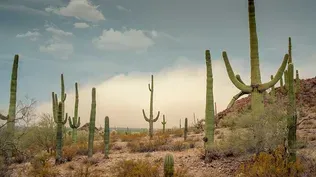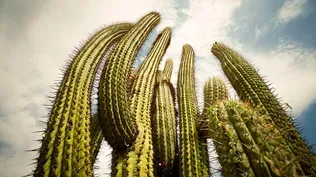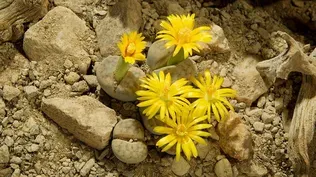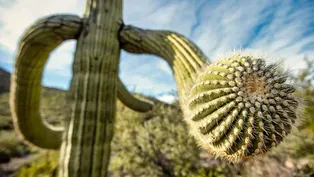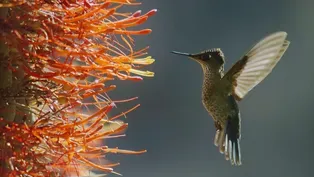

Desert Worlds
Episode 4 | 55m 55sVideo has Audio Description, Closed Captions
Sir David Attenborough explores desert plants with survival tactics.
Sir David Attenborough explores the hostile world of the desert, where plants can spend decades waiting for rain or travel to find it. Survival tactics include using weapons, camouflage and forming surprising alliances with animals.
See all videos with Audio DescriptionADProblems with Closed Captions? Closed Captioning Feedback
Problems with Closed Captions? Closed Captioning Feedback

Desert Worlds
Episode 4 | 55m 55sVideo has Audio Description, Closed Captions
Sir David Attenborough explores the hostile world of the desert, where plants can spend decades waiting for rain or travel to find it. Survival tactics include using weapons, camouflage and forming surprising alliances with animals.
See all videos with Audio DescriptionADProblems with Closed Captions? Closed Captioning Feedback
How to Watch The Green Planet
The Green Planet is available to stream on pbs.org and the free PBS App, available on iPhone, Apple TV, Android TV, Android smartphones, Amazon Fire TV, Amazon Fire Tablet, Roku, Samsung Smart TV, and Vizio.
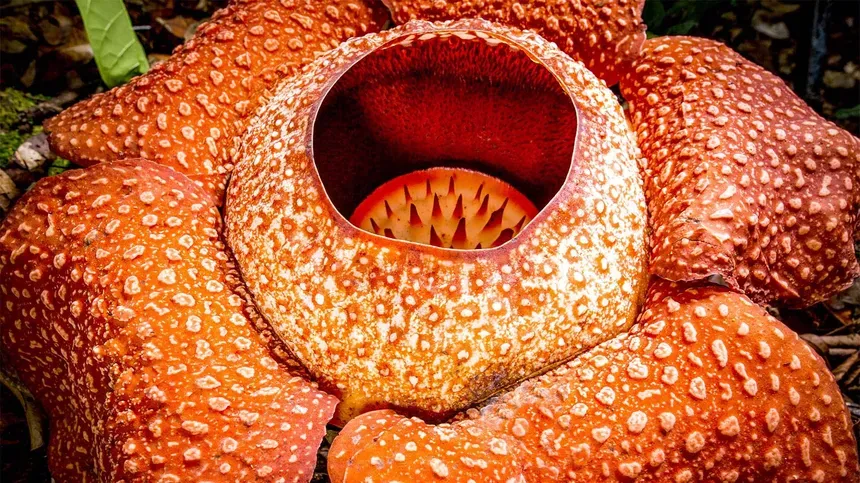
The Green Planet
Dive into the extraordinary world of plants with articles from The Green Planet.Providing Support for PBS.org
Learn Moreabout PBS online sponsorship♪ ♪ ♪ ♪ Sir David Attenborough: The Taklamakan Desert in northern China.
A constantly shifting landscape of sand.
Temperatures that swing from below freezing to more than 100 degrees Fahrenheit.
And most critically, almost entirely...without rain.
Yet, here on the dunes... ♪ a Euphrates poplar tree.
♪ And it's not alone.
Some of these trees have lived here for 1,000 years.
♪ ♪ They have exceptionally long roots with which to collect water.
And what is more, those roots are connected to neighboring trees so that if one strikes water, others can share it.
♪ In every desert across the planet, plants have found ways to not only survive but flourish.
♪ ♪ This is the Gran Desierto of Mexico and the United States.
♪ ♪ These dunes may appear to be totally barren.
In fact, they are full of life.
In the sands beneath my feet, there are seeds of many different kinds.
In fact, you could say that the dune itself is one great seed bank, and when it rains, it bursts into life.
[Thunder] But rain may come only once a decade, and even then, the long-awaited storm may be very brief.
♪ So, seeds must respond immediately.
♪ ♪ This is sand verbena.
It can grow from a seed to a sweetly scented flowering plant in just a few weeks.
♪ Primroses and many other plants soon join the race to flower before the sand dries.
♪ Desert blooms like this, however, are rare.
♪ This is the first year for 20 years.
♪ The combination of vibrant color and powerful scent attracts migrating pollinators, such as these painted lady butterflies, which fly into the middle of what were, only recently, barren dunes.
Everything is rushing to complete their lives before the moisture has gone.
♪ Such spectacular blooms transform deserts all around the world... ♪ ♪ from the Atacama in South America... ♪ to the dusty plains of southern Africa.
♪ ♪ Rain in deserts, however, never lasts long, and all too soon, the flowers wither and die.
But not before they've produced the next generation... the seeds that will now wait in the sand for the next rains.
In the Sonoran desert of North America, the huge saguaro cacti have a different strategy.
They store water in quantity and can live to a great age.
But in their early years, they are extremely vulnerable.
This little saguaro cactus is about 10 years old.
When they're really small and growing out in the open, there's a real chance that they may shrivel up and die, but this one has been lucky.
It's been growing in the shade of this mesquite tree and it's got a very good chance of surviving to maturity.
The young saguaro is protected by the mesquite's branches.
They halve the amount of scorching sunlight reaching the cactus, and so, keep it cool.
♪ And the mesquite's extremely long roots draw up water, bringing it within reach of the young saguaro.
♪ So, the mesquite is known as a nurse plant, and a very effective one it is, too.
In fact, this particular mesquite has already nurtured 7 young saguaros over the past 30 years.
♪ As a young cactus grows, it needs the protection of its nurse plant, not only from the heat but from the other hazards of desert life.
♪ Temperatures can drop to below freezing overnight... ♪ and very occasionally, it even snows.
♪ If the water stored inside a young cactus should freeze, the cactus will die.
♪ But the nurse plant traps a blanket of slightly warmer air around it, just enough to keep it alive.
♪ Eventually, saguaros outgrow their nurses, but by that time, they are robust enough to face the elements by themselves.
No matter how old a desert plant is, water is always precious, whether gathered from melting snow... [Thunder] or a shower of rain.
♪ ♪ So, cacti have developed extraordinary adaptations that enable them to not only collect water... but to retain it.
♪ Instead of leaves, which would lose precious moisture through evaporation, they have spines.
Each spine has a tiny pad at its base where the water is absorbed... ♪ and then stored in the great swollen trunk.
♪ A large saguaro can hold over 1,000 gallons of water and is able to do so because it has another special adaptation.
♪ The ridges on its surface are like the pleats on an accordion.
They allow the saguaro to change its shape.
♪ After rain has fallen, the pleats expand and the saguaro fills up its water tank.
♪ In the dry times, it uses its water to grow, produce flowers, and, eventually, seeds.
Fully loaded with water, this saguaro won't need to drink a single drop for another year.
But such valuable stores of water attract thieves.
Now the spines' function changes from collection...to guarding.
♪ The spines of some species are like spheres, 10 inches long.
♪ Others are needle-like barbs that grow in clusters and easily break off in the skin of any animal that touches them.
♪ But perhaps the most vicious cacti belong to a group called the chollas.
This is called a teddy bear cholla because of the thick coating of spines on it.
But don't be deceived by the name.
There is nothing cuddly about this particular teddy bear.
In fact, it's the most dangerous plant in the desert, and I wouldn't dream of putting my hand anywhere near it without proper protection.
Brush against it... this could happen.
Ow!
This can happen even with this glove on.
One of them has just gone through.
I can feel it.
It's quite painful.
♪ Look closely at a spine and you can see very clearly why they're so dangerous.
Each is like a splinter of glass, sharp enough to pierce flesh, and they're covered with backward-pointing barbs.
So, getting them out, even with a pair of pliers, is quite hard.
This is not pleasant at all.
They won't come off without... oh, look at that.
It's hard to imagine a more aggressive defense than this.
And it makes both the plant and its buds virtually invulnerable.
Most animals know to keep clear.
Cholla buds roll like tiny barrels from the top of the adult plant and then drop off.
[Wolf barks] If the young cholla put down roots here, it would compete with its parent for water.
♪ Night falls...and this one is on the move.
♪ ♪ A pack rat.
She knows how to deal with a cholla.
♪ She avoids the spines by gripping it at the place where it broke off from its parent.
♪ And she works fast.
♪ There are pack rat hunters here.
♪ She uses the cholla to build a spiny wall around her nest.
♪ ♪ The flesh of the cholla supplies her with water... ♪ and the severed spines further reinforce the defenses.
♪ ♪ This cholla bud... might be next.
♪ But one accidental nudge... ♪ and it escapes.
♪ ♪ ♪ The bud starts to put down roots.
♪ So, the cholla, thanks to the pack rats, finds new territory and sets about claiming it.
♪ Few plants deal with the problems of desert living better than cacti.
There are almost 2,000 different species of them.
♪ Copiapoa cacti grow as clusters to provide shade for each other.
♪ Barrel cacti swell into rounded forms, which reduces evaporation.
♪ And Creeping Devil cactus search for water by crawling over the ground an inch a decade... ♪ absorbing its rear in order to extend its front.
♪ Yet in the desert world, water thieves can come in many forms... to exploit even the smallest chink in a plant's defense.
♪ In South America, the ice-covered peaks of the Andes act as a rain barrier... beyond which lies the world's driest desert, the Atacama.
♪ In the desert world, water thieves can come in many forms, to exploit even the smallest chink in a plant's defense.
♪ One of the strangest travels within the gut of a fruit-eating mockingbird.
[Mockingbird squawking] These are the seeds of tristeryx, a kind of mistletoe.
♪ Their goal is the water inside this hedgehog cactus.
♪ Using the spines as anchors, the seeds start to germinate.
♪ Each produces a long probe with which to try and locate the cactus' skin.
♪ For most, that's a stretch too far, and they perish.
♪ But for this one, the cactus' surface is within reach.
♪ It clamps onto it with a special sucker.. ♪ and then waits for darkness.
♪ At night, the cactus opens its pores in order to respire.
♪ Oxygen goes in... ♪ and so does tristeryx.
♪ Once within, its tissues spread throughout the body of the cactus, sustained by the precious store of water that they find there.
[Thunder] Then a year later, it breaks through the cactus' skin... ♪ and bursts into flower.
♪ ♪ Hummingbirds come to drink their nectar and pollinate them as they do so.
♪ ♪ And then, to complete the cycle, tristeryx produces hundreds of white, eye-catching seeds, ready to be carried away by a bird to invade another cactus.
♪ ♪ The Karoo desert in southern Africa.
♪ And although it may look bare, its rocky ground contains an unrivaled variety of plants that, one way or another, store water in their tissues.
♪ They belong to many different families but, as a group, they're known as succulents.
♪ ♪ Some are small and low and barely distinguishable from their surroundings.
♪ These look like little pebbles.
♪ They resemble them so closely that animals which might be only too glad to steal their water just pass them by.
♪ When rain does fall, they absorb it and quickly expand.
♪ But even this doesn't spoil their disguise.
They just look like larger pebbles.
Nor are they green.
The cells on their top surface are transparent and allow sunlight to pass through.
♪ Deep within and out of sight are the green cells where photosynthesis occurs, the process which uses this light to make food for the plant.
♪ When the time comes to reproduce, however, the stone plant abandons its disguise.
♪ ♪ ♪ And now it blooms.
♪ The flowers open and close every 24 hours.
♪ So, for a few dangerous days, the plant advertises for pollinators before returning to life as a pebble.
♪ Some desert plants have developed a very different way of attracting pollinators.
This is stapelia.
It produces what is perhaps a desert's strangest disguise.
It uses water stored in its stems to grow buds the size of tennis balls.
The flower, once open, is called a desert starfish.
Instead of releasing millions of loose pollen grains as most flowers do, the desert starfish produces them packed in 5 tiny sacks.
But if its strategy is successful, just one of them will produce hundreds of seeds.
And this depends on deception.
♪ The flower appears to have hair... ♪ wrinkly skin... ♪ and it produces a stench like the carcass of a dead animal.
♪ ♪ And when a carrion fly investigates... ♪ the flower clamps a tiny sack of pollen to its proboscis.
♪ It's not easy to feed with such encumbered mouth parts.
But try as it might, the fly can't get rid of it.
♪ And it's still there when the fly leaves to try and feed from another bogus carcass.
♪ This time, however, when its clamped-up proboscis slots into the flower, the pollen sack is released.
♪ With pollination complete, the fly is no longer needed.
♪ And just as well.
Some deserts can be so dry that plants must find techniques of surviving for long periods without any water whatsoever.
One of them is to grow extremely slowly, and few plants grow more slowly than this one-- the creosote bush.
It is inactive for most of its life and only wakes up and grows for a brief period, if and when there is a fall of rain.
I've seen evidence of this grow-slow strategy for myself.
40 years ago, I came here to California's Mojave desert to visit one particular plant.
An individual creosote bush tends to spread not by setting seeds and producing a new generation but by sending out new stems around its base.
This plant started growing between 10,000 and 12,000 years ago.
That was in 1982.
♪ Since then, careful measurement has shown that it has increased its size by less than one inch.
♪ Its ability to endure is truly extraordinary.
♪ So efficient is creosote at collecting what little rain falls here that few other plants can compete with it.
As a result, over the last 12,000 years, it's come to completely dominate this landscape.
♪ ♪ The Chihuahuan desert in north Mexico.
Here, one particular plant plays the waiting game so well that it spends much of its life looking dead and certainly not worth eating... and it can survive like this for a decade.
This is the resurrection plant.
It's a kind of moss.
It barely has roots and it certainly can't store much water, but it can travel.
After a particularly long drought... it breaks away from its roots... and becomes...a tumbleweed.
♪ Blowing across the desert, it can travel a mile in a week.
♪ With luck, it may find water.
♪ [Thunder] ♪ Just a shower of rain can bring it back to life.
♪ As its fronds soak up the water, they unfurl.
♪ ♪ In its protected center, it still has green cells, which absorb both the water and sunlight and rapidly produce the food it needs to resume its growth.
♪ It'll grow for just as long as there is moisture.
♪ But when that disappears... it closes up once more... and resumes its travels.
♪ ♪ The great American deserts cover over a million square miles.
♪ Here, baked by the sun and blasted by the wind, the rocks disintegrate to create a landscape of plunging canyons and towering pinnacles.
♪ All across this vast region, the seeds of one of the desert's most remarkable plants can wait for over a century for the right conditions before it can awake.
♪ Rain does occasionally fall here and turns dust into mud.
♪ But that doesn't last long.
A brief window of opportunity opens.
♪ ♪ Seeds that have been buried for years may now be exposed to light and come to life.
♪ ♪ This is coyote tobacco.
♪ ♪ In just a few weeks, it grows over 3 feet tall and produces dozens of flowers.
♪ The night air becomes heavy with their fragrance.
♪ Soon, they attract hawk moths, which sip their nectar and, in doing so, pollinate them.
But the moths also lay their eggs on them.
♪ ♪ Soon, their caterpillars have hatched and are munching the leaves.
♪ Their nibbles expose the plant's sap to the drying air.
♪ But the tobacco plant has a defense.
♪ The leaves under attack produce nicotine.
♪ This chemical sedates the caterpillars and slows them down.
♪ And what is more, it makes them give off a particular scent-- ♪ one that summons others to come to the plant's aid.
♪ Big-eyed bugs.
Miniature assassins barely 1/16 of an inch long.
And whip tail lizards.
Big or small, they make a meal of the caterpillars.
♪ ♪ It's certainly effective.
But there's more to this strategy than meets the eye.
When the leaf of a tobacco plant is attacked by a caterpillar, all the rest of the leaves prepare to defend themselves, but how does this leaf know that that leaf there is under attack?
Well, scientists here in the United States have specially genetically modified these tobacco plants so that under special lighting conditions, this microscope can show us exactly what is going on.
I'm going to attack one of the leaves of this plant with these tweezers, which to the plant will seem as if it's being nibbled by a caterpillar.
♪ ♪ Signals are being transmitted along the veins that link the leaf to the rest of the plant.
It's rather like a very simple nervous system.
♪ From that initial injury, the whole of this little plant is aware that something has happened.
♪ This signal warns each leaf of the danger, so that it is ready to produce nicotine the moment it's attacked.
♪ With this defense at the ready, the tobacco plant can continue to grow until, eventually, it produces seeds.
♪ ♪ It's particularly important in deserts for seeds to be distributed as widely as possible so that some will have a chance of meeting moisture.
And deserts have an excellent agent to help them do that.
The wind.
♪ Many seeds have adaptations to help them exploit it.
They have shells to protect the seeds within from abrasion... or wings to help them catch the air.
♪ As the temperature rises throughout the day, desert winds increase in strength.
♪ ♪ ♪ Here in Arizona, the land is regularly swept by what is known as a haboob.
It's a giant sandstorm, but also in effect a seed storm.
♪ Countless millions of them are swept up into the air.
♪ Some seeds can travel thousands of miles on the wind... ♪ [Thunder] so that plants may eventually reach even the most isolated desert.
[Thunder] ♪ Some have landed on an island in the middle of the world's largest salt flat in Bolivia.
♪ In the Galapagos, they sprout on fields of recently erupted lava.
♪ And along the dry eastern coast of Madagascar... desert plants have created the junglelike spiny forest.
♪ Desert plants have even reached one of the most inhospitable of all sites, the tiny island of San Pedro Martir, a scorched, lonely rock off the coast of Mexico.
♪ Over 1,000 years ago, a seed found itself marooned here.
Exposed and with little water or shade, its chance of survival was slim.
Yet, remarkably, it grew into one of these... ♪ a Giant Cardone.
♪ A species of huge cactus that can weigh up to 12 tons.
♪ They're able to thrive here because of an extraordinary partnership... ♪ with brown and blue-footed boobies.
♪ The cardones here can become so broad that they provide cooling shade for nesting birds.
♪ ♪ As the booby chicks get older, they repay the cardones... ♪ with their droppings.
Guano.
The digested remains of vast shoals of fish.
This guano is of such strength and quantity that most plants would be poisoned by it.
[Birds squawking] These cardones, however, have evolved the ability to tolerate the toxins in the guano and digest the nutrients.
As a result, the cacti now grow in a dense forest over a million strong.
But such relationships are very finely balanced and can only too easily tip into catastrophe... as is now happening in northern Zimbabwe.
For 6 months of the year, the savannah here is kept lush and green by daily rains.
♪ But when the rainy season is over, it becomes as dry as any desert.
♪ ♪ So, to survive here, trees must be able to tolerate both conditions.
♪ And these giants are adapted to do just that.
They are baobabs.
♪ Known here as "the tree of life," such is their importance as a source of shade and food.
♪ ♪ This one might be over 1,000 years old.
It survives here thanks in part to its ability to store thousands of gallons of water within the spongy wood of its trunk.
♪ But its battered surface is evidence of a very finely balanced relationship.
♪ These huge trees are a focus of animals of all kinds.
♪ And they're particularly important for elephants.
♪ In the wet season, they eat the baobab's fruit and disperse the seeds in their dung.
♪ Now as the dry season begins... [Elephant grunts] they migrate to distant watering holes.
♪ The baobabs have damp inner wood... ♪ and the elephants use it to quench their thirst on the journey.
[Elephant roars] ♪ [Elephant rumbling] This relationship can only work because baobabs have a remarkable ability to heal themselves.
♪ ♪ Between each damaging attack, they expand their spongy wood and grow new skin.
♪ And they've done this time and time again over centuries.
♪ Today, however, it's harder for the baobabs to recover, as dry seasons become longer and drier due to climate change.
♪ Not only that, but the elephants are forced to take ever more wood from the trees in order to survive.
♪ In some parts of Africa, many of the largest and oldest baobabs have fallen in the last decade.
♪ ♪ The loss of a vital species like the baobab strikes a blow at all life in the desert.
♪ In these hostile lands, few living organisms can survive without help from others.
♪ You can find an extraordinary illustration of this in Arizona's saguaro country.
If you wander off the beaten track here, you may be lucky enough to find one of these.
It might look like an old boot, but in fact, it's part of a saguaro cactus.
Almost every saguaro has one.
There's one up there.
♪ It has been produced indirectly by woodpeckers, which regularly dig homes for themselves in the bloated trunks of the saguaros.
♪ ♪ In the next 6 months, the cactus heals the wound and so creates a safe, cool, and watertight nest hole.
♪ Its tough lining will persist for years, even after the cactus itself has died and rotted away.
♪ A single saguaro may hold several of these extraordinary homes.
♪ So, over its lifetime, it may provide accommodation for some 3,000 chicks of several different species.
[Bird squawking] [Bird chirping] But in the long term, the saguaro benefits as their lodgers repay the cactus by pollinating its flowers... and dispersing its seeds.
[Birds chirping] [Bees buzzing] It's relationships like these that enable life to flourish in some of the world's harshest landscapes.
Over millions of years, plants have become superbly adapted to hostile desert conditions, but it's a very finely balanced existence and one that makes them uniquely vulnerable.
♪ However, our growing understanding of the complex ways by which desert animals and plants rely on one another is now helping us to understand how best we can protect them.
♪ 90 years ago, a photograph was taken from this very spot that shows a population of saguaro cactus that was very different from what it is today.
♪ In the last 50 years, the population of saguaros here has greatly diminished, not because of a direct assault on the cactus but because many of the shade-giving nurse trees were harvested for firewood, leaving young saguaro to die in the sun.
♪ Now that this relationship is understood and the nurse trees are protected, there are already signs that the saguaro are recovering.
♪ Wherever there's a desert, plants have evolved to meet its challenge.
♪ But everywhere, they need our help.
♪ As we understand more about them and their intimate and complex relationships, we will be better able to protect them... and all life in these beautiful but increasingly fragile worlds.
♪ ♪ (soft orchestral music) - [David] The most remote shoot for the deserts team is to the Island of San Pedro Martir, in the Sea of Cortez, Mexico.
They are to film the giant cacti that have found a unique way to thrive here.
It takes 48 hours to travel the 260 miles over unpleasantly-choppy seas.
(dramatic music) As they draw close to the island, there's a spectacular reminder of how rich life in the sea is here.
- [Man] Oh, look in front of us.
Look, a dolphin pod.
(laughing) - Oh, they're everywhere.
(dramatic music) - Show us the way.
(man laughing) - [David] Meeting them here is desert scientist, Ben Wilder.
It's through his research that the team first heard about the Island's peculiar residents.
- I'll never forget the first time I came to actually exactly where we're standing right now.
It was April of 2006 and saw this view and it both settled in my heart and captivated my mind.
And so that started a process of trying to understand what can produce this?
(intriguing music) - [David] The secret is in the relationship between the cactus and a type of seabird called a booby, but even this island isn't isolated from the effects of a changing planet.
- Every cactus you see there, its body is filled with nutrients from the sea.
Given that we know that the cardons are linked to the ocean, what happens in the oceans affects what happens to the cardon.
So a concern we have right now is that there's a lot of overfishing and we know there are less sea birds here than there were 20 years ago.
And we have reason to believe then that will ripple and affect the nutrients that fuel the cardons as well.
(ethereal music) - [David] This finely-balanced relationship is at risk and knowing that makes leaving the island particularly thought provoking for the crew.
- The cardons look beautiful.
I've never seen so many cactus in my life.
It is absolutely amazing.
I'm just hoping that when we leave this place, it stays as it is and things don't affect it negative.
It's an absolutely wonderful thing.
And yeah, I don't wanna go.
I wanna stay, so yeah.
- [David] This remote cactus forest is a reminder of the adaptability of plants that enables them to establish green worlds almost anywhere on earth.
How Saguaro Cacti Store 1000 Gallons of Water
Video has Closed Captions
Clip: Ep4 | 2m 9s | The saguaro features a pleated surface which allows it to expand. (2m 9s)
The Plant that Makes Its Home on a Cactus
Video has Closed Captions
Clip: Ep4 | 3m 16s | Tristerix seeds travel in bird droppings to invade the bodies of giant cactus. (3m 16s)
Why Elephants Eat the Baobab Tree
Video has Closed Captions
Clip: Ep4 | 2m 38s | The baobab stores thousands of gallons of water in its spongy wood. (2m 38s)
Providing Support for PBS.org
Learn Moreabout PBS online sponsorshipSupport for PBS provided by:
